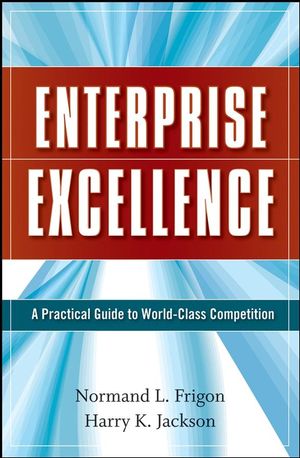|
Textbook
Enterprise Excellence: A Practical Guide to World Class CompetitionISBN: 978-0-470-27473-6
Hardcover
496 pages
December 2008, ©2009
 |
||||||
Law of Unintended Consequences.
Enterprise Excellence.
Enterprise Excellence Model.
Continuous Measurable Improvement.
Achieving Enterprise Excellence.
Key Points.
Chapter 2: Managing and Leading Enterprise Excellence.
Lead People - Manage Things.
Management Systems.
Leading Enterprise Excellence.
The Leadership Model .
Leading and Managing Teams.
Effective Meetings.
Understanding and Overcoming Resistance to Change.
The 3Cs: Communication, Cooperation, and Coordination.
Key Points.
Chapter 3: Enterprise Excellence Deployment.
Enterprise Excellence Infrastructure .
Deployment Measurement, Analysis and Reporting.
Enterprise Excellence Deployment Planning.
Establishing Enterprise Excellence Policies, Guidelines and Infrastructure.
Key Points.
Chapter 4: Enterprise Excellence Implementation.
Management and Operations Plans.
Enterprise Excellence Projects.
Enterprise Excellence Project Decision Process .
Planning The Enterprise Excellence Project.
Tollgate Reviews.
Project Notebook.
Key Points.
Chapter 5: Listening to the Voice of the Customer.
Voice of the Customer (VOC).
Answering the Voice of the Customer.
Technology Development.
Development of Products, Services and Processes.
Quality Function Deployment.
CDOV Process.
Key Points.
Chapter 6: Define (Knowing and Understanding Your Processes).
Understanding Process Variation.
Acquire All Process Documentation.
Process Mapping.
Value Stream Mapping.
Value Stream Analysis.
Process Walkthrough.
Failure Modes and Effects Analysis.
Key Points.
Chapter 7: Measure.
Process Measurement.
Statistical Process Control.
Statistical Process Control Charts.
Control Charts Analysis.
Variation.
Type of Control Charts & Applications.
Attribute Control Charts.
Process Capability Analysis.
Measurement Systems Evaluation (MSE).
Gauge Reproducibility & Repeatability (R&R).
Transactional MSE.
Key Points.
Chapter 8: Analyze and Improve Effectiveness.
Analysis of Variance.
One-Way ANOVA.
Two-Way ANOVA.
Linear Contrasts.
Design of Experiments.
Key Points.
Chapter 9: Analyzing and Improving Efficiency.
5S Process.
The Seven Forms of Waste.
Takt Time.
Cycle Time.
Routing Analysis.
Spaghetti Diagram.
Work Content Analysis.
Process Availability Analysis.
Process Yield Measures.
Cycle Time.
Just in Time.
Kanban.
Mixed-Model Production.
A B C Material Handling.
Workable Work.
Workload Balancing.
One Piece Flow.
Work Cell Design.
Kanban Sizing.
Key Points.
Chapter 10: Control and Continuous Measurable Improvement.
Management Systems.
Statistical Process Control.
Visual Controls.
Graphic Work Instructions.
Mistake Proofing (Poka-Yoke).
Single-Minute Exchange of Die (SMED).
Total Productive Maintenance.
Rapid Improvement Events.
Continuous Measurable Improvement.
Key Points.
Appendix A: Bibliography.
Appendix B: Glossary.
Appendix C: Basic Math Symbols.
Appendix D: List of Acronyms.



